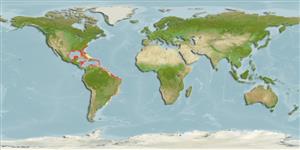sub class Elasmobranchii (ฉลามและกระเบน) (sharks and rays) >
Carcharhiniformes (Ground sharks) >
Carcharhinidae (Requiem sharks)
Etymology: Carcharhinus: karcharos (Gr.), sharp or jagged; rhinus, an ancient name for sharks, from rhine (Gr.), rasp, both words alluding to a shark's jagged, rasp-like skin (See ETYFish); acronotus: acro-, from akron (Gr.), top, summit or peak; notus, from notos (Gr.), back, allusion not explained, perhaps referring to “raised” (translation) back at first dorsal fin (See ETYFish).
More on author: Poey.
Environment: milieu / climate zone / depth range / distribution range
นิเวศวิทยา
เกี่ยวกับทะเล,น้ำเค็ม เกี่ยวกับหินโสโครก; ระดับความลึก 9 - 64 m (Ref. 50072), usually 9 - ? m (Ref. 55176). Subtropical; 40°N - 37°S, 100°W - 33°W (Ref. 55176)
Western Atlantic: North Carolina, USA to southern Brazil and Uruguay (Ref. 58839), including the Gulf of Mexico and the Caribbean.
Length at first maturity / ขนาด / น้ำหนัก / Age
Maturity: Lm 110.7, range 87 - 137 cm
Max length : 200 cm TL เพศผู้/กระเทย; (Ref. 244); น้ำหนักสูงสุดที่มีการรายงาน: 18.9 kg (Ref. 40637); อายุสูงสุดที่ได้รายงาน: 20 ปี (Ref. 108669)
Found on continental and insular shelves, mainly over sandy, shell, and coral bottoms. Feeds on small fishes, including pinfish (Sparidae) and porcupine fish. Preyed on by larger sharks. Viviparous (with a yolk-sac placenta), with 3 to 6 young per litter. Performs a 'hunch' display, with back arched, caudal lowered and head raised, as a possible threat display when confronted by divers. Utilized dried salted for human consumption. Minimum depth from Ref. 055176.
Viviparous, placental (Ref. 50449), with 3 to 6 young per litter (Ref. 244). Distinct pairing with embrace (Ref. 205).
Compagno, L.J.V., 1984. FAO Species Catalogue. Vol. 4. Sharks of the world. An annotated and illustrated catalogue of shark species known to date. Part 2 - Carcharhiniformes. FAO Fish. Synop. 125(4/2):251-655. Rome: FAO. (Ref. 244)
IUCN Red List Status (Ref. 130435: Version 2024-2)
Human uses
การประมง: มีการค้าเพียงเล็กน้อย; การตกปลาเป็นกีฬา: ใช่
เครื่องมือ
Special reports
Download XML
แหล่งที่มาจากอินเตอร์เน็ต
Estimates based on models
Preferred temperature (Ref.
123201): 22.2 - 28, mean 25.5 °C (based on 520 cells).
Phylogenetic diversity index (Ref.
82804): PD
50 = 0.5000 [Uniqueness, from 0.5 = low to 2.0 = high].
Bayesian length-weight: a=0.01122 (0.00514 - 0.02450), b=3.04 (2.87 - 3.21), in cm total length, based on all LWR estimates for this body shape (Ref.
93245).
ระดับชั้นอาหาร (Ref.
69278): 4.4 ±0.5 se; based on diet studies.
ความสามารถในการกลับคืนสู่ปกติ (Ref.
120179): ต่ำ, เวลาต่ำสุดที่จะทำให้ประชากรเพิ่มขึ้นเป็น 2 เท่าใช้เวลา 4.5 - 14 ปี (K=0.12; tm=3; tmax=15; Fec=4).
Prior r = 0.44, 95% CL = 0.29 - 0.66, Based on 1 full stock assessment.
Fishing Vulnerability (Ref.
59153): High vulnerability (60 of 100).
Nutrients (Ref.
124155): Calcium = 4.6 [0.8, 24.8] mg/100g; Iron = 0.382 [0.095, 1.094] mg/100g; Protein = 23 [20, 25] %; Omega3 = 0.156 [0.059, 0.385] g/100g; Selenium = 13.2 [4.0, 40.1] μg/100g; VitaminA = 34.1 [11.8, 102.7] μg/100g; Zinc = 0.367 [0.171, 0.718] mg/100g (wet weight);
